How do you choose and make your base?
The first step in creating your own e-liquids is choosing and making your DIY base. Below we describe the various options, PG/VG proportions, and how they are put into practice.
The first step in creating your own e-liquids is choosing and making your DIY base. Below we describe the various options, PG/VG proportions, and how they are put into practice.
 An e-cigarette liquid is essentially made up of a base, flavours, and optionally nicotine. We will discuss the last two in specific articles, but the base represents around 80 to 90% of the overall liquid, and is the source of the vapour itself. On its own, it is practically tasteless – hence the need for flavours – and provides virtually no hit – hence the need for nicotine. That doesn’t mean that all bases are the same, however.
An e-cigarette liquid is essentially made up of a base, flavours, and optionally nicotine. We will discuss the last two in specific articles, but the base represents around 80 to 90% of the overall liquid, and is the source of the vapour itself. On its own, it is practically tasteless – hence the need for flavours – and provides virtually no hit – hence the need for nicotine. That doesn’t mean that all bases are the same, however.
The DIY base is made up of vegetable glycerin (“VG”) and/or propylene glycol (“PG”), in variable proportions. Therefore, it is up to you to choose the composition that is the best fit for you.
 For everything you needed to know about propylene glycol, feel free to refer to our special article on the substance. In brief, when choosing your base, it has a number of key properties to take into account. Increasing the propylene glycol content in your base will:
For everything you needed to know about propylene glycol, feel free to refer to our special article on the substance. In brief, when choosing your base, it has a number of key properties to take into account. Increasing the propylene glycol content in your base will:
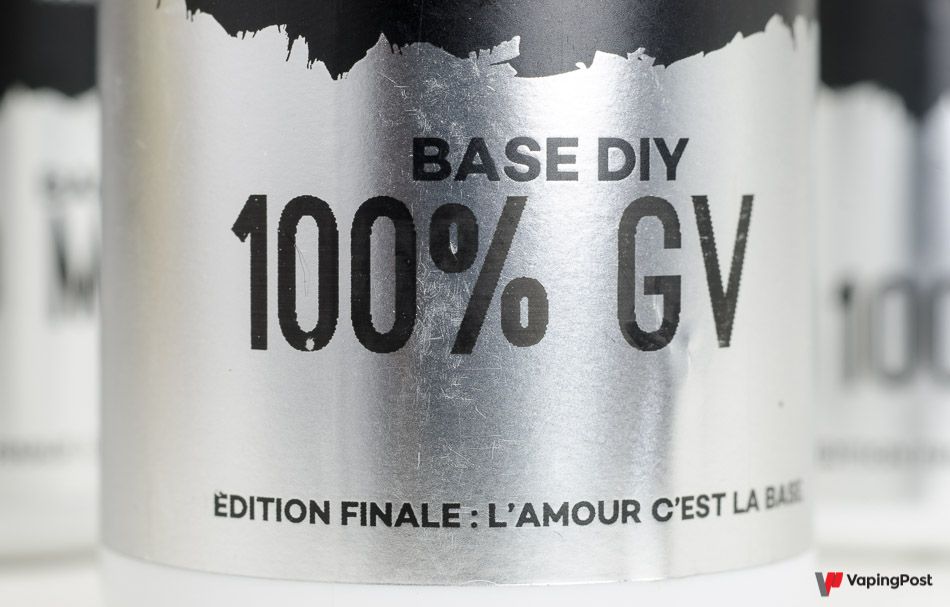 The main thing that you need to know in this case is that increasing the vegetable glycerin content in your base will:
The main thing that you need to know in this case is that increasing the vegetable glycerin content in your base will:
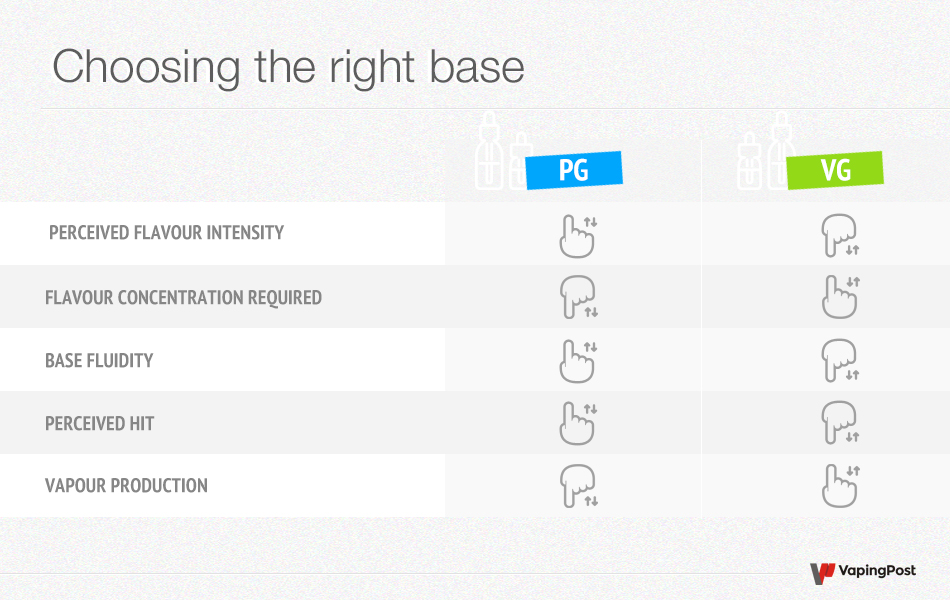
While it is possible to choose gear based on appearance or price factors, the most important factor should be the vaping experience it offers. First of all, choose your vaping style, then an atomizer suited to this style, followed by a box or a mod to make it work, and, finally, a suitable liquid. This order is critical, you need to choose the desired vaping experience first, and then the gear that offers it. 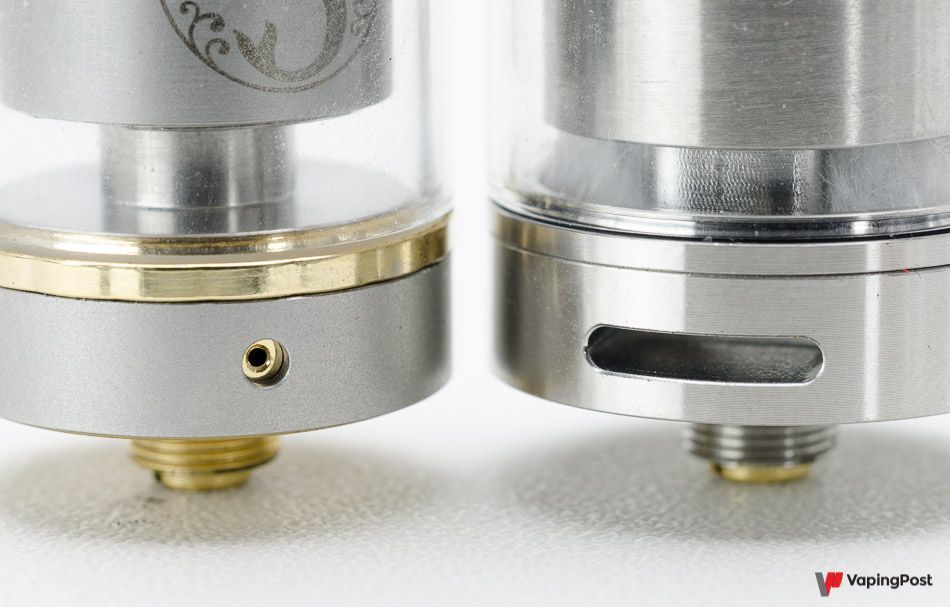 The two main characteristics of an atomizer are linked; they consist of the vaping power offered, and its more or less open airflow. Low powers, for example 10 Watt, will correspond to a tight airflow and often indirect vaping. High powers go hand in hand with an open airflow and direct vaping.
The two main characteristics of an atomizer are linked; they consist of the vaping power offered, and its more or less open airflow. Low powers, for example 10 Watt, will correspond to a tight airflow and often indirect vaping. High powers go hand in hand with an open airflow and direct vaping.
In the first case, the hit is the most important factor, and there will not be much vapour in any event. Bases with higher propylene glycol contents are the best fit. In the second case, you will get more vapour with a base containing more glycerin, which is also not as irritant and better suited to high powers. 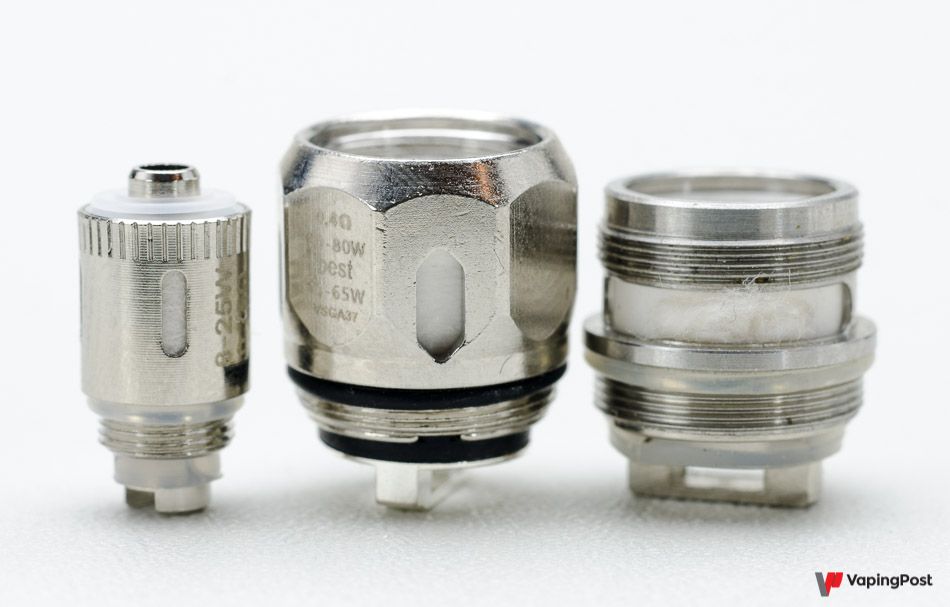 Incidentally, atomizers are designed accordingly. Resistance coils envisaged for 10 Watt vaping have small liquid inlets, due to their low liquid consumption. They work better with fluid liquids: bases with a high glycerin content are more viscous, and have difficulty passing through these small inlets, and you may get a dry hit. On the other hand, resistance coils envisaged for high powers have wide liquid inlet openings to cope with high consumption, and overly fluid bases are liable to cause leaks or clogging of the resistance coil.
Incidentally, atomizers are designed accordingly. Resistance coils envisaged for 10 Watt vaping have small liquid inlets, due to their low liquid consumption. They work better with fluid liquids: bases with a high glycerin content are more viscous, and have difficulty passing through these small inlets, and you may get a dry hit. On the other hand, resistance coils envisaged for high powers have wide liquid inlet openings to cope with high consumption, and overly fluid bases are liable to cause leaks or clogging of the resistance coil.
Obviously, you have plenty of scope to play with, and the only rule you need to follow is that only your personal preferences matter. However, you could start with an average base containing 50%PG / 50%VG, and opt for more PG for low-power indirect vaping and a tight airflow, for example 70%PG / 30%VG. Conversely, you could opt for more VG for higher-power, indirect vaping, with an open airflow.
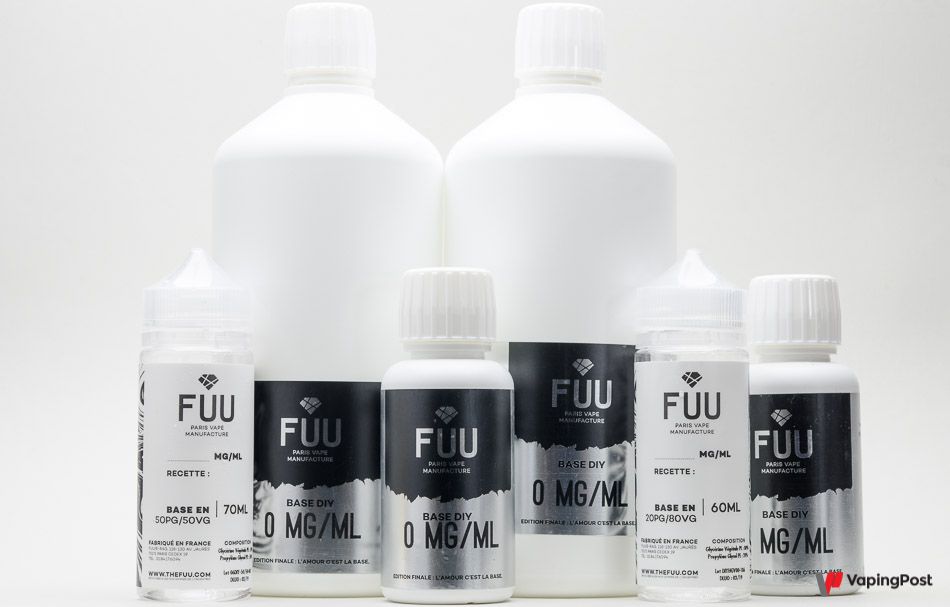 The simplest solution is obviously to buy a DIY base in ready-to-use format. Bases with different PG/VG proportions are available, generally from 20/80 to 80/20. The first figure indicates the propylene glycol content, the second the vegetable glycerin content. This is a common notation format, but make sure to check the contents of each component, as some manufacturers invert the two figures. You can also vape with 100% VG, if you have an intolerance to PG or you want to “chase clouds”; vaping with 100% PG, on the other hand, is highly unconventional, as it can easily cause irritation and fails to provide satisfactory vapour production.
The simplest solution is obviously to buy a DIY base in ready-to-use format. Bases with different PG/VG proportions are available, generally from 20/80 to 80/20. The first figure indicates the propylene glycol content, the second the vegetable glycerin content. This is a common notation format, but make sure to check the contents of each component, as some manufacturers invert the two figures. You can also vape with 100% VG, if you have an intolerance to PG or you want to “chase clouds”; vaping with 100% PG, on the other hand, is highly unconventional, as it can easily cause irritation and fails to provide satisfactory vapour production.
You are more likely to find these bases in 100, 250, 500 and 1000 millilitre bottles, and some manufacturers offer units of up to 5 litres. You can adapt according to your vaping habits, and, for example, if you generally vape at 40 Watt and occasionally at 10 Watt, when you want or need to produce less vapour, choose one 30/70 base in 1 litre format and one 70/30 base in 100 ml format. In this way, you can make two versions of your favourite liquid, each in a suitable atomizer that you use according to your mood.
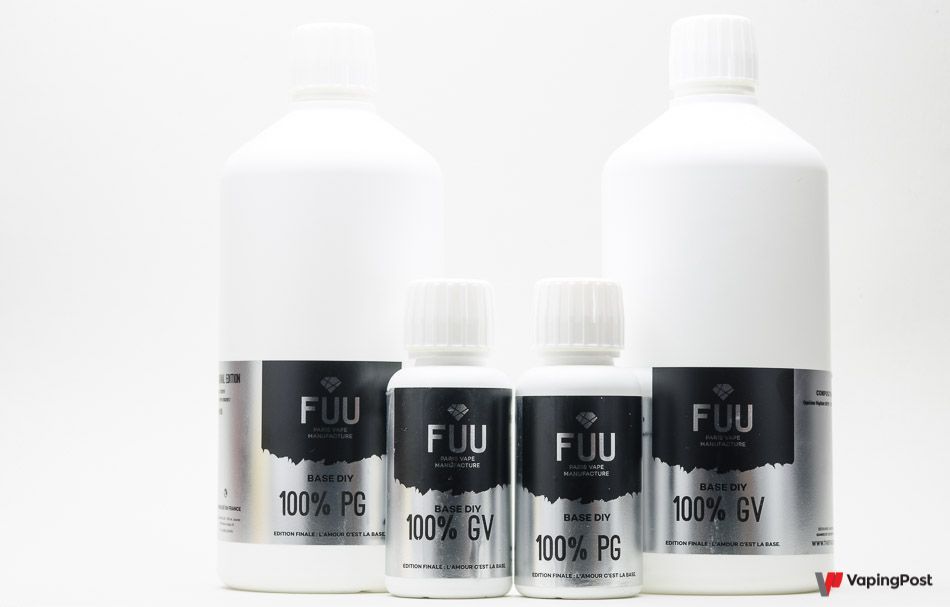 For more flexibility or if you are looking for a blend in between the standard mixtures available, you can make your own base by mixing propylene glycol and vegetable glycerin using your own proportions. In this way, you can easily adapt your base to the liquid that you intend to make, and to the vaping style that are envisaging, with just two bottles, one of PG and one of VG.
For more flexibility or if you are looking for a blend in between the standard mixtures available, you can make your own base by mixing propylene glycol and vegetable glycerin using your own proportions. In this way, you can easily adapt your base to the liquid that you intend to make, and to the vaping style that are envisaging, with just two bottles, one of PG and one of VG.
It goes without saying that you must only use products devised and sold for vaping for these two components. Their purity and the absence of other components are guaranteed, protecting your health. You can, however, buy pure PG and VG in pharmacies – make sure that the composition is 100% – but they are often more expensive and harder to get, particularly in the case of PG, than in vaping stores. Therefore, this is not your best option, but keep it under your hat just in case.
Making the mixture couldn’t be simpler: for example, to make a base containing 70%PG / 30%VG, simply mix… 70% PG with 30% VG. No need for a PhD in chemistry to say the least! So, to make 100 ml of this 70PG / 30VG base, measure 70 ml of PG and pour into a bottle or container, add 30 ml of VG, mix well, and there you have it. 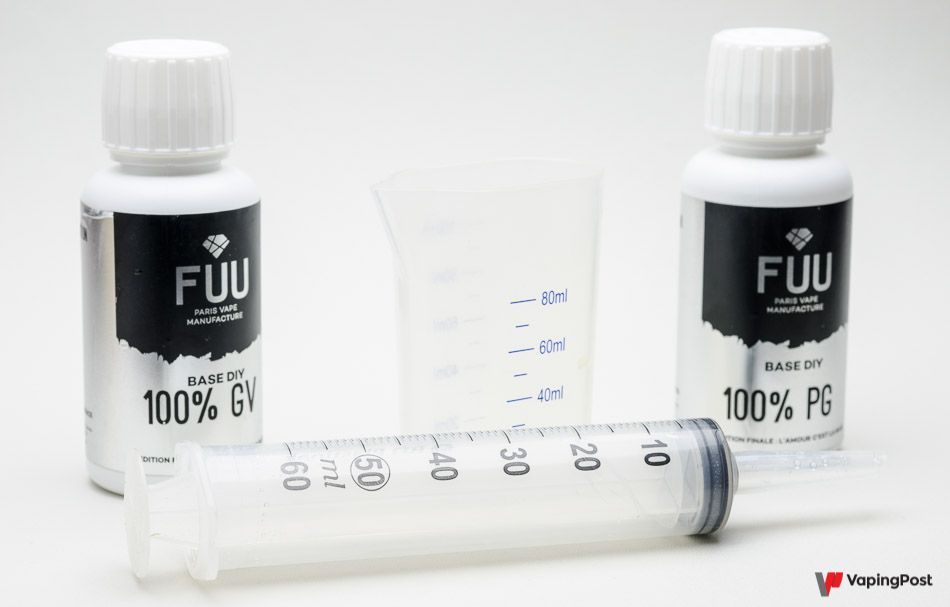 You can use food-grade glass or plastic for the container. This also applies when mixing flavours and nicotine, if needed, only use food-grade containers. For the dosage, you can use a graduated glass vessel or a syringe. All capacities of graduated glass vessels are available, and I have found syringes of up to 60 ml. That shown in the photo is available from pharmacies and used by veterinarians to administer oral medication to cattle. It’s called DIY for a reason, you can improvise! As long as you keep to products specifically intended for vaping, food or medical purposes – we can’t stress this enough.
You can use food-grade glass or plastic for the container. This also applies when mixing flavours and nicotine, if needed, only use food-grade containers. For the dosage, you can use a graduated glass vessel or a syringe. All capacities of graduated glass vessels are available, and I have found syringes of up to 60 ml. That shown in the photo is available from pharmacies and used by veterinarians to administer oral medication to cattle. It’s called DIY for a reason, you can improvise! As long as you keep to products specifically intended for vaping, food or medical purposes – we can’t stress this enough.
You can make the mixture in a separate container or straight in the bottle to be used for storage. I prefer this option, simply because it is easy to mix by shaking the bottle once you have closed it again. Obviously for the bottle, if you are planning on recycling a motor oil can, you haven’t been paying attention, so go back to the start of this article.
Finally, to complete the picture, you can also measure your ingredients with scales. For this, you will need scales with a precision of at least one gram. This doesn’t mean that the display should be in grams, but that the measurement precision must be within one gram, unlike basic kitchen scales. You will also need to perform some more arithmetic to obtain the measurements in volume, to take the densities of the components into account. The density of vegetable glycerin is 1.26 g/cm³, that of propylene glycol is 1.04 g/cm³.
We have prepared a series of articles examining DIY liquids: